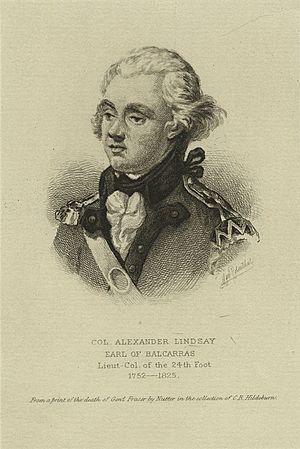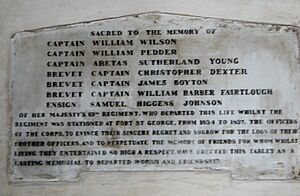63rd (West Suffolk) Regiment of Foot facts for kids
Quick facts for kids 63rd (West Suffolk) Regiment of Foot |
|
|---|---|
| Active | 10 December 1756 – 1 July 1881 |
| Country | |
| Branch | |
| Type | Line Infantry |
| Role | Infantry |
| Size | One battalion (two battalions 1804–1814) |
| Garrison/HQ | Wellington Barracks, Ashton-under-Lyne |
| Nickname(s) | "The Bloodsuckers" |
| Colors | (Scarlet until 1881) Deep Green Facings, Silver Braided Lace |
| March | Quick: Slow: |
| Engagements | American Revolutionary War French Revolutionary Wars Napoleonic Wars Crimean War |
The 63rd Regiment of Foot was a British Army regiment. It was first formed in 1756. This group of soldiers served in many important wars. These included the American Revolutionary War and the Crimean War.
In 1881, the regiment joined with another group, the 96th Regiment of Foot. Together, they became the Manchester Regiment. This change was part of big army updates called the Childers Reforms.
Contents
History of the 63rd Regiment
Starting the Regiment and the Seven Years' War
The 63rd Regiment of Foot was created because the army needed more soldiers. This was at the start of the Seven Years' War in 1756. At first, it was the 2nd Battalion of the 8th Regiment of Foot. It became the 63rd Regiment on April 21, 1758.
Later that year, the 63rd Regiment went to the West Indies. In 1759, they tried to invade Martinique but it didn't work. Soon after, they helped invade Guadeloupe. British troops landed and took over the main town, Basse-Terre.
The regiment stayed in the West Indies for five more years. They faced many attacks. Their leader, Lieutenant-Colonel Peter Desbrisay, was killed during one attack.
Fighting in the American War of Independence
In 1775, the regiment arrived in America. They were sent to help in the American War of Independence. In June 1775, they fought in the Battle of Bunker Hill. Their third attack, using bayonets, finally broke through the American lines.
After the battle, the regiment stayed in Boston. But the city became unsafe. In March 1776, they left Boston for Halifax, Canada. They then fought in the Battle of Long Island in August 1776. This was a big defeat for the Americans.
Smaller groups from the regiment also fought in other battles. These included the Battle of Brandywine and the Battle of Germantown in 1777. The main part of the regiment fought in the Battle of Forts Clinton and Montgomery. In 1778, they were part of the Battle of Monmouth.
In 1780, the regiment went to the Carolinas. They helped capture Charleston. They also fought in other battles with Lord Cornwallis. In 1782, the regiment was named the 63rd (the West Suffolk) Regiment of Foot.
French Revolutionary and Napoleonic Wars

In 1794, the regiment joined British forces in the Flanders Campaign. They fought in several battles there. The British forces left the Netherlands in 1795.
That same year, the regiment was going to the Caribbean. Their ship sank, and two companies of soldiers were lost. The regiment then helped stop a rebellion in Grenada in 1796. They stayed in the Caribbean until 1799.
In August 1799, the regiment took part in the Anglo-Russian invasion of Holland. They fought in the Battle of Alkmaar. In 1801, they moved to Gibraltar, and then to Ireland in 1803.
A second group of soldiers, called a battalion, was formed in 1804. In 1807, the 1st battalion went to Madeira. The Portuguese governor there agreed to all British demands. In 1808, the 1st battalion was in Barbados. They helped capture Martinique.
The 1st battalion then stayed in Martinique. Many soldiers got sick from tropical diseases. In 1810, part of the 1st battalion helped capture Guadeloupe. This was a duty the regiment had done many years before. The 1st battalion left the Caribbean in 1819.
Meanwhile, the 2nd battalion fought in the Walcheren Campaign in 1809. Many soldiers got a terrible fever during this campaign.
The Victorian Era

From 1820 to 1826, the regiment was in Ireland. In 1827, they went to Portugal. This was because there were fears of a rebellion there. The British forces helped calm things down.
In 1829, the regiment started escorting ships carrying prisoners to Australia. These ships went to New South Wales and Van Diemen's Land (now Tasmania). The rest of the regiment stayed as soldiers in Tasmania. Some soldiers were at the founding ceremony of Perth in 1829.
The regiment moved from Australia to India in 1833. They went to Mawlamyine in Burma in 1838. They returned to India in 1842, and then to England in 1847.
The Crimean War
In August 1854, the regiment arrived in Kalamita Bay. They were part of the 4th Division for the Crimean War. In November 1854, they fought in the Battle of Inkerman. There was a lot of hand-to-hand fighting.
During this battle, both soldiers carrying the regiment's flags fell. Ensign James Hulton Clutterbuck carried the Queen's Colour. Ensign Heneage Twysden, who was badly wounded, carried the Regimental Colour.
The regiment also took part in the Siege of Sevastopol. On September 8, 1855, they were part of an attack on the fortress of Sevastopol. This was on the last day of the long siege.
Joining Forces: Amalgamation
After leaving Crimea, the regiment sailed to Nova Scotia in 1856. When they arrived in Halifax, thousands of people came to greet them. It was like a modern-day sports team arriving!
The regiment returned home in 1865. Then, in 1870, they went to India. In the 1870s, the British Army made changes called the Cardwell Reforms. These reforms linked single regiments together. The 63rd Regiment was linked with the 96th Regiment of Foot. They shared a training base in Ashton-under-Lyne.
On July 1, 1881, more changes happened. These were called the Childers Reforms. The 63rd Regiment of Foot officially joined with the 96th Regiment of Foot. Together, they formed the new Manchester Regiment.
Battle Honours
Battle honours are special awards given to regiments. They show which important battles or campaigns the regiment fought in and won. The 63rd Regiment earned several battle honours:
- Egmont-op-Zee (from the War of the Second Coalition)
- Martinique 1809 and Guadeloupe 1810 (from the Napoleonic Wars)
- Alma, Inkerman, and Sevastopol (from the Crimean War)
- Afghanistan 1879-80 (from the Second Anglo-Afghan War)
Sources


